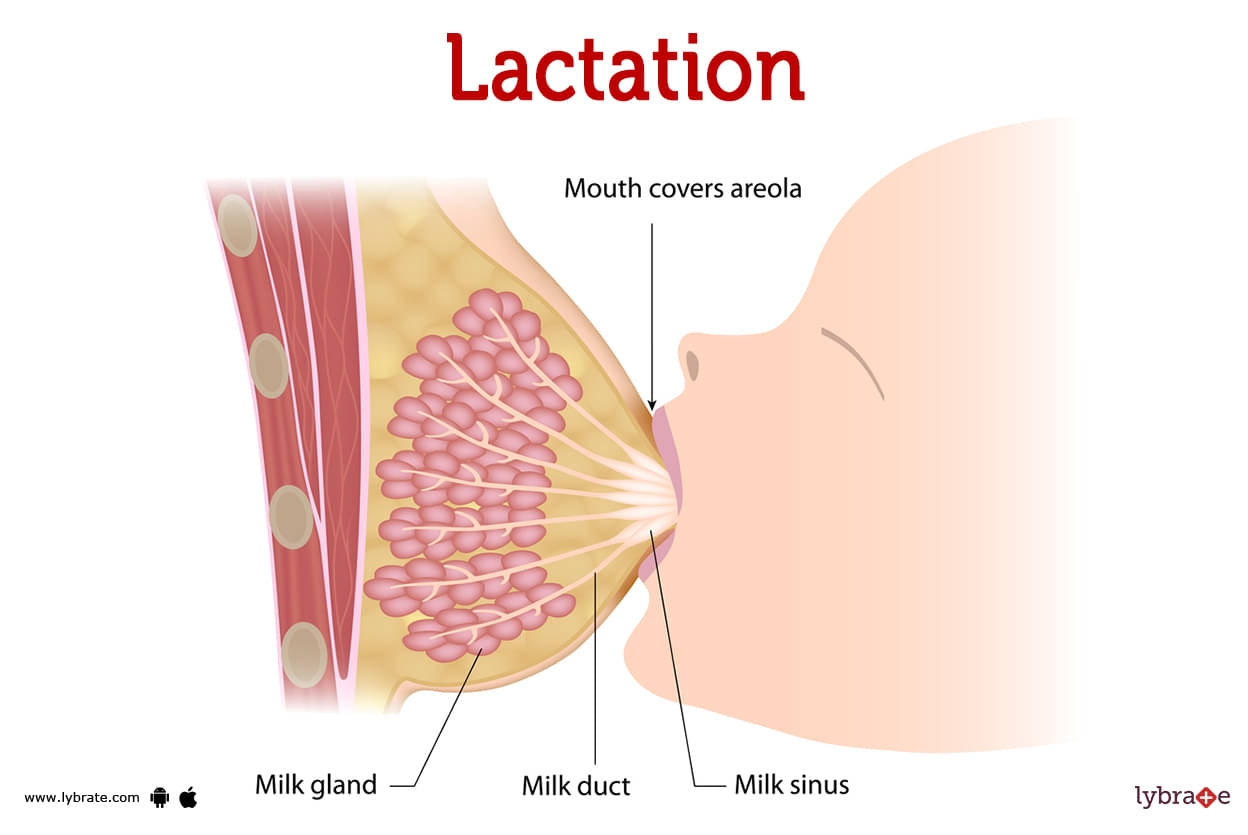Lactation (Human Anatomy): Image, Functions, Diseases and Treatments
Last Updated: Nov 24, 2022
Lactation Image
The process of lactation results in the production of human milk. Your mammary glands, that are found in your breasts, secrete human milk. In pregnant people, lactation naturally occurs and is hormone-driven. It also can be induced in non-pregnant people.
As long as the milk is being drawn from your breasts, lactation will continue. The method of producing and releasing milk from your mammary glands in your breasts is called lactation. When hormonal changes occur during pregnancy, the mammary glands are supposed to start producing milk in order to get ready for the birth of your child.
The same hormones that your body produces during pregnancy can be used to cause lactation without a pregnancy. Your body will stop producing milk once lactation is over.
Breastfeeding (or chestfeeding) or nursing refers to feeding your baby directly from your breasts. You can also give your baby breast milk which you have expressed or pumped from your breasts and saved in a bottle.
Where does human milk come from?
Human milk is produced by the mammary glands located within your breasts. These glands are made up of several components which work together to make and secrete milk:
- Alveoli: These tiny grape-shaped sacs, or alveoli, produce and store milk. Each lobule is connected to a lobe, which is a grouping of alveoli.
- Milk ducts: Each lobe is connected to its own milk duct. Up to twenty lobes are possible, with one milk duct per lobe. Milk ducts transport milk from the lobules of the alveoli to the breasts.
- Areola: The dark area surrounding your nipple that contains nerve endings that signal your body when to produce milk. The entire areola must be stimulated for lactation to occur.
- Nipple: There are up to 20 tiny pores in your nipple that let milk out. Nerves on your nipple respond to sucking (either by a baby, your hands or a breast pump). This makes your brain tell your alveoli to send milk through your milk ducts and out of your nipple. It helps to imagine the lactation system as a big tree. Your nipple is the tree's trunk. The milk ducts are like branches. The alveoli are the leaves.
Why do people lactate?
Infant nutrition is the primary motivation for lactation. Lactation is a hormonal response that begins during pregnancy and continues after delivery in order to provide nourishment for the infant. Hormones are secreted by the body to start the process of milk production and expulsion (releasing of milk). For this reason, lactation is a normal physiological process in all mammals, and it is possible to enhance lactation in men and in non-pregnant women by administering certain hormone medications.
What triggers lactation?
Lactation is triggered by a hormonal cascade that begins during pregnancy. The scientific name for this transformation is lactogenesis.
Stage one lactogenesis: This begins around the 16th week of pregnancy and lasts until a few days after you give birth.
- Milk ducts swell in size and number as oestrogen and progesterone levels rise. Your breasts will swell as a result of this. Your ductless glands in your breasts start getting ready to secrete milk.
- The skin around your areolas and nipples gets darker.
- The oil that lubricates your nipple comes from your Montgomery glands, which are small bumps located on the areola.
- Your body will now start the process of producing colostrum. In addition to being rich in nutrients and satisfying, it can be used as your infant's first milk.
Stage two lactogenesis: This stage starts about two or three days postpartum (after giving birth). It’s when milk production intensifies.
- When your child and placenta are delivered, your levels of oestrogen and progesterone suddenly fall, which triggers the hormone prolactin to take over.
- The hormone responsible for milk production is called prolactin.
- At this point, you'll notice a significant rise in milk output. It's also known as 'milk coming in.'
- Your breasts are frequently engorged (or too full of milk), causing them to feel unpleasant, painful, or tender.
Stage three lactogenesis: This describes the rest of the time you lactate.
Generally, lactation persists as long as milk is extracted from the breast.
The more milk is lost, the more milk is produced to replace it. Frequent breastfeeding or pumping stimulates milk production.
Hormones for lactation
- The hormone prolactin regulate how much milk you make, and your body starts making it soon after you find out you are pregnant. Initially, the high levels of oestrogen, progesterone, and other hormones related to pregnancy make prolactin less effective. Once the placenta is delivered, the hormones of pregnancy stop and prolactin takes over.
- Sucking by your baby causes a surge in the hormones prolactin and oxytocin because it triggers a response from the mother's nervous system. The hormones prolactin and oxytocin work together to stimulate the alveoli to produce milk, which is then expelled via the milk ducts due to the contraction of surrounding muscles.
- A letdown occurs when milk is discharged; this usually takes around 30 seconds of sucking. Since you have no say over which breast gets the hormones, the letdown can result in milk dripping from both nipples.
- Medication that simulates the hormones that are produced by the body during pregnancy is required in order to stimulate lactation in those who are not pregnant. The act of sucking from the nipple can start lactation, and this can be done either by a baby or using a breast pump. This is a complicated process that requires close cooperation with a healthcare provider who is familiar with the requirements of persons who are not pregnant and who has previous experience with beginning breastfeeding.
How do you stop lactation?
There are several reasons why you may need to cease breastfeeding, and you can do it either naturally or with the use of hormonal medicines.
Natural milk suppression
Lactation is a process of supply and demand. Your milk production steadily decreases as your infant becomes less dependent on breast feeding, or as you lower the frequency with which you breastfeed or pump. If you reduce the amount of milk extracted from your breasts, your body will often produce less milk. It might be uncomfortable to suppress your milk, and most women will get engorged (the term for overfilled breasts). You may also have milk leakage or a blocked milk duct. However, this discomfort can be alleviated by taking an over-the-counter pain killer, wearing a tight bra, or applying an ice pack to the breasts.
Medication suppression
If you need to quit Taking medicine is another option if you need to stop producing milk. Your doctor can tell you more about drugs that stop you from breastfeeding, as well as the advantages and potential side effects.
What is hormone therapy for inducing lactation?
Couples or families who wish to induce lactation, maybe because of adoption, surrogacy or other reasons, can try hormone therapy. With induced lactation, you cause your body make milk without being pregnant. Taking oestrogen and progesterone for a few months will trick your body into thinking it's pregnant. This helps get your breasts ready for breastfeeding. Some medicines and herbs are thought to help get a milk supply going as well.
Start pumping using a breast pump a few weeks before you're due to have your baby. The hormone prolactin, responsible for lactation, is stimulated in this way. You should express your milk multiple times a day, exactly as you would if you were having a child. This aids in securing a reliable supply. Any extra breast milk you pump may be frozen for use once the baby is born.
It's important to discuss your plans to breastfeed with your doctor if you want to know more about the safety and efficacy of human milk. Many mothers are successful with induced lactation, however this is not the case with everyone.
Lactation Conditions and Disorders
Different women have different thresholds for lactation and different milk-making windows. While some mothers are able to breastfeed their babies for years, others struggle to produce enough milk.
There are many things that can affect lactation and nursing, but some of the most frequent include:
- Hormonal levels and conditions.
- Medications.
- Undergoing radiation therapy in the past.
- Trauma to your breast or nipples.
- Breast augmentation, reconstruction or other breast surgeries.
- Other medical conditions like HIV infection.
- Use of drugs and alcohol.
Always check with your doctor before beginning any new medicine or therapy while breastfeeding or pumping breast milk for bottle-feeding. Breast milk is a potential route for drug transfer to a nursing infant, which can have serious consequences.
What is lactational amenorrhea?
Amenorrhea (ah-men-oh-re-uh) is the medical term for a condition in which a woman is unable to menstruate (have her period) because she is breastfeeding her child. When a woman is breastfeeding, her body generates prolactin, which is the hormone responsible for milk production.
Your body's production of luteinizing hormone (LH), which plays a role in the process of ovulation by helping to initiate the release of an egg, is decreased by prolactin. You won't be able to ovulate or receive your period if you aren't producing a sufficient amount of LH.
The amount of time that a woman can be amenorrheic owing to breastfeeding ranges anywhere from a few months up until the point where she is no longer breast feeding her child.
Does lactation reduce my risk of any diseases?
Studies reveal that a woman's chance of developing breast and ovarian cancer is lower if she breastfeeds her child. Additionally, it can reduce the likelihood that you will develop type 2 diabetes or high blood pressure.
How do you maintain milk production?
The main principle governing lactation maintenance is supply and demand. Your body will produce more milk the more your infant breastfeeds or the more you use a breast pump to release milk. Hormones and oral contraceptives are two ways for reducing lactation. Some actions you should take if you want to continue breastfeeding are:
- Continue breastfeeding on demand or regularly pump milk (approximately every four hours).
- Consume a balanced diet rich in calories. Low-calorie diets may reduce milk production.
- Stay hydrated by drinking lots of water. Human milk is largely composed of water.
- Avoid using tobacco, narcotics, or alcohol. These have the potential to lower your supply and transfer to your milk.
Lactation Medicines
- Steroids for reducing inflammation of Lactation
- Analgesics for pain in Lactation
- Muscle relaxants for stiffness in Lactation
- Antibiotics for infection in Lactation
- Nutritional supplements for reducing pain in Lactation
- Supplements for promotion of growth at the time of fracture of Lactation
- Antivirals for treating infection of Lactation
- Chemotherapeutic medicines for Lactation
Table of content
Find Gynaecologist near me
Ask a free question
Get FREE multiple opinions from Doctors



